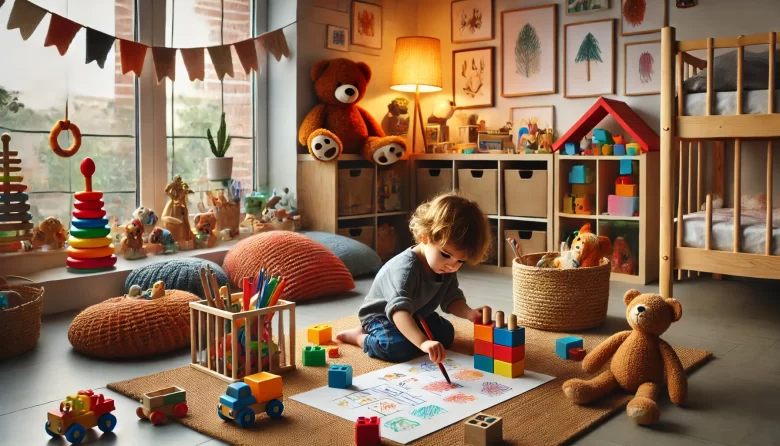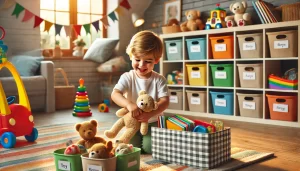Encouraging independent play is one of the best ways to help children develop creativity, problem-solving skills, and confidence in their own abilities. When children learn to play and explore on their own, they become more self-sufficient, develop longer attention spans, and improve their ability to entertain themselves without constant supervision.
Many parents worry that their child won’t play independently or that they need to provide constant engagement. However, with the right environment and encouragement, independent play can become a natural and enjoyable part of your child’s day.
In this guide, we’ll explore why independent play is essential, how to create the right environment, and what strategies you can use to help your child learn through self-directed activities.
Why Is Independent Play Important?
Independent play is much more than just keeping children busy—it plays a critical role in their development. Here’s how:
- Boosts Creativity: When children play on their own, they use their imagination to create stories, solve problems, and invent new ways to use toys and materials.
- Improves Problem-Solving Skills: Without an adult guiding every step, children learn to figure things out on their own, boosting critical thinking.
- Enhances Focus and Attention Span: Engaging in independent play helps children build concentration and persistence in completing tasks.
- Develops Emotional Resilience: Playing alone allows children to explore emotions, practice patience, and manage frustrations without immediate external intervention.
- Encourages Self-Sufficiency: Learning to entertain themselves fosters independence, confidence, and self-reliance.
Now that we understand the benefits, let’s look at how to create the perfect environment for independent play.
Set Up a Play-Friendly Environment
The right environment makes a huge difference in promoting independent play. A cluttered or overstimulating space can be distracting, while a well-organized area encourages exploration and creativity.
How to Set Up the Space:
✔ Keep Toys Organized: Store toys in bins or baskets where they are easily accessible. Rotating toys every few weeks keeps things fresh and interesting.
✔ Create Defined Play Zones: Have specific areas for building blocks, art supplies, books, or pretend play.
✔ Limit Overstimulation: Too many toys or loud, flashing electronics can overwhelm a child. Simple, open-ended toys work best.
✔ Provide a Safe Space: Ensure the play area is childproofed so your child can explore safely without constant supervision.
By creating an inviting and structured play environment, children naturally gravitate toward independent activities.
Use Open-Ended Toys and Materials
Some toys are designed for passive play (like electronic gadgets that do all the work), while others encourage creativity and engagement. Open-ended toys allow children to use their imagination in multiple ways.
Best Open-Ended Toys for Independent Play:
Building Blocks (LEGO, wooden blocks, magnetic tiles) – Great for spatial awareness, problem-solving, and creativity.
Dolls and Figurines – Encourage role-playing and storytelling.
Books – Let children explore stories and develop literacy skills.
Art Supplies (crayons, paper, stickers, glue) – Support self-expression and fine motor development.
Toy Cars, Trains, or Animal Figures – Perfect for pretend play and creating scenarios.
Puzzles – Strengthen focus and cognitive skills.
The more ways a child can use a toy, the longer they will stay engaged.
Start Small and Build Up Playtime
Some children may struggle with independent play at first, especially if they are used to constant entertainment from adults or screens. The key is to start small and gradually extend the time they spend playing alone.
How to Encourage Longer Play Sessions:
Set a Timer: Start with just 5-10 minutes of independent play and gradually increase the time as your child becomes more comfortable.
Incorporate Independent Play into Daily Routine: Set a consistent time each day for solo play, such as after breakfast or before nap time.
Step Away Gradually: Sit near your child while they play independently, then slowly move farther away over time.
Praise Their Efforts: Acknowledge and celebrate their independent play achievements. “Wow! You built an amazing tower all by yourself!”
With practice, your child will learn to enjoy their own company and extend play sessions naturally.
Allow Boredom and Avoid Over-Scheduling
Many parents feel pressured to constantly entertain their children with activities, but allowing children to experience boredom can actually be beneficial. Boredom sparks creativity and encourages kids to find their own ways to engage with their surroundings.
How to Use Boredom Positively:
- Resist the Urge to Immediately Intervene: When your child says, “I’m bored,” wait and see if they come up with an idea on their own.
- Provide Open-Ended Prompts: Instead of suggesting a specific activity, ask, “What could you build with these blocks?” or “What adventure could your toy animals go on?”
- Limit Screen Time: Excessive screen use can reduce a child’s ability to entertain themselves. Keep screen time limited to encourage hands-on play.
Boredom can be the gateway to imaginative and independent thinking!
Encourage Pretend Play and Storytelling
Pretend play is one of the best ways for children to engage in independent learning. It allows them to explore different roles, practice social skills, and use their creativity.
Ways to Encourage Pretend Play:
Create a Play Kitchen or Store – Let kids “cook” meals or sell imaginary groceries.
Use Dress-Up Clothes – Old hats, scarves, or costumes let kids act out different characters.
Make DIY Puppets – Encourage them to put on a puppet show with stuffed animals or homemade puppets.
Let Them Create Their Own Stories – Give them a notebook to draw and write their own adventures.
By giving kids the tools to pretend and explore, they’ll naturally engage in deeper play.
Teach Children How to Play Independently
Some children don’t naturally know how to play on their own, and that’s okay! They may need guidance on how to start an activity before feeling confident enough to continue independently.
Ways to Guide Your Child into Independent Play:
✔ Demonstrate Play: Show them how to build a tower with blocks or set up toy animals in a pretend farm.
✔ Play Together First: Start an activity with them, then slowly let them take over while you step back.
✔ Ask Open-Ended Questions: “What do you think will happen next in your story?” or “How can you build an even taller tower?”
Helping children learn how to start an activity gives them the confidence to continue on their own.
Introduce Simple Challenges and Problem-Solving Activities
Best for: Critical thinking and perseverance
Independent play becomes even more valuable when children learn to solve problems on their own. Providing small challenges encourages resilience and boosts confidence in their abilities.
Ways to Incorporate Challenges into Play:
Puzzles and Brain Games: Start with simple puzzles and gradually increase difficulty.
STEM Challenges: Ask your child to build a bridge with blocks or create a ramp for toy cars.
Creative Art Prompts: Give them an open-ended challenge, like “Can you draw an animal that doesn’t exist?”
Encouraging problem-solving within play helps children become more independent thinkers.
Foster a Growth Mindset During Independent Play
Best for: Building resilience and confidence
A growth mindset helps children understand that they can improve skills with effort and practice. This is especially important when they play independently and face small obstacles.
How to Encourage a Growth Mindset:
✔ Praise Effort, Not Just Results: Instead of saying, “You’re so smart,” say, “I love how hard you worked on that tower!”
✔ Encourage Trying Again: If they get frustrated, remind them, “Mistakes help us learn. Let’s try a new way!”
✔ Use Positive Language: Teach them to say, “I can’t do this… YET!” instead of “I can’t do this.”
When children see play as a space to explore and grow, they’ll feel more comfortable experimenting and solving problems on their own.
Rotate Toys and Materials to Keep Play Engaging
Best for: Preventing boredom and sparking creativity
Children can quickly lose interest in toys that are always available. A simple trick to keep play fresh is toy rotation—storing some toys away and reintroducing them later.
How to Rotate Toys Effectively:
Divide toys into small groups and store some out of sight.
Every few weeks, swap out old toys for “new” ones from storage.
Make it exciting! Say, “Look what we found! Let’s see what we can build with this today!”
Toy rotation makes old toys feel new again and prevents overstimulation from having too many options at once.
10. Be Patient and Allow for Unstructured Playtime
Best for: Encouraging deep focus and long-lasting play sessions
One of the biggest mistakes parents make is interrupting children when they’re engaged in independent play. It’s important to give them space and avoid stepping in too quickly.
Tips for Supporting Unstructured Play:
Give them enough time to get deeply engaged—it can take a few minutes before they fully immerse in play.
Resist the urge to “help” too soon—if they’re struggling with a task, see if they figure it out first.
Let them repeat activities—kids often repeat the same play patterns as a way of mastering concepts.
When children have uninterrupted time, they develop longer attention spans and become more confident in their ability to entertain themselves.
Final Thoughts
Independent play is an essential skill that helps children develop creativity, confidence, problem-solving abilities, and patience. By creating a play-friendly environment, using open-ended toys, encouraging pretend play, and allowing boredom, you give your child the tools to explore and learn on their own.
Remember, independent play is a gradual process—start small, be consistent, and watch as your child grows more self-sufficient in their learning and exploration!




